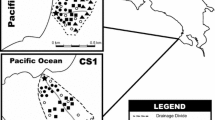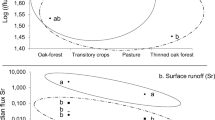Abstract
The study was conducted in five contiguous small watersheds (12–28 ha) gauged for long-term ecosystem research. Five 80 × 30 m plots were used for the study. We quantified inputs from the atmosphere, dissolved and particulate-bound losses, throughfall and litterfall fluxes, standing crop litter and soil available P pools. Mean P input and output for a six-year period was 0.16 and 0.06 kg⋅ha−1⋅yr−1, respectively. Phosphorus concentration increased as rainfall moved through the canopy. Annual P returns in litterfall (3.88 kg/ha) represented more than 90% of the total aboveground nutrient return to the forest floor. Phosphorus concentration in standing litter (0.08%) was lower than that in litterfall (0.11%). Phosphorus content in the litterfall was higher at Chamela than at other tropical dry forests. Mean residence time on the forest floor was 1.2 yr for P and 1.3 yr for organic matter. Together these results suggest that the forest at Chamela may not be limited by P availability and suggest a balance between P immobilization and uptake. Comparison of P losses in stream water with input rates from the atmosphere for the six-year period showed that inputs were higher than outputs. Balances calculated for a wet and a dry year indicated a small P accumulation in both years.
Similar content being viewed by others
References
Agbenin JO & Tiessen H (1994) Phosphorus transformations in a toposequence of Lithosols and Cambisols from semi-arid northeastern Brazil. Geoderma 62: 345-362
APHA (1992) American Public Health Association, American Water Works Association, Water Pollution Control Federation. Métodos normalizados. Díaz de Santos, Madrid
Bruijnzeel LA (1991) Nutrient input-output budgets of tropical forest ecosystem: A review. J. Trop. Ecol. 7: 1-24
Bullock SH & Solís Magallanes A (1990) Phenology of canopy trees of a tropical deciduous forest in Mexico. Biotropica 21: 22-35
Burgos A (1999) Dinámica Hidrol.ógica del bosque tropical seco en Chamela, Jalisco, México. MSc Thesis, Universidad Nacional Aut ´ønoma de México, México
Campo J (1995) Ciclo del fósforo en un ecosistema tropical estacional. PhD Dissertation, Universidad Nacional Autónoma de México, México
Campo J, Jaramillo VJ & Maass JM (1998) Pulses of soil phosphorus availability in aMexican tropical dry forest: effects of seasonality and level of wetting. Oecologia 115: 167-172
Campo J, Maass JM, Jaramillo VJ & Martínez-Yrízar A (2000) Calcium, Potassium, and Magnesium cycling in a Mexican tropical dry forest ecosystem. Biogeochemistry 49: 21-36
Campo, J, Maass JM & De Pablo L (2001) Mineral weathering in a Mexican tropical dry forest. Agrociencia 35: in press
Castellanos J (1998) Efecto de la roza, tumba y quema sobre la dinámica de las raíces finas de una selva baja caducifolia. MSc Thesis, Universidad Nacional Autónoma de México, México
Castellanos J, Maass M & Kummerow J (1991) Root biomass of a dry deciduous tropical forest in Mexico. Plant Soil 131: 225-228
Cervantes L,Maass JM & Domínguez R (1988) Relación lluvia-escurrimiento en un sistema pequeño de cuencas de selva baja caducifolia. Ing. Hidraúl. Segunda época 3: 30-42
Cross AF & Schlesinger WH (1995) A literature review and evaluation of the Hedley fractionation: Applications to the biogeochemical cycle of soil phosphorus in natural ecosystems. Geoderma 64: 197-214
Cuevas E & Medina E (1988) Nutrient dynamics within Amazonian forests. 2. Growth, nutrient availability and leaf litter decomposition. Oecologia 76: 222-235
Díaz S (1997) Dinámica de nitrógeno y fósforo en la hojarasca de una selva baja caducifolia en Chamela, Jalisco, México. Bachelor Thesis, Universidad Nacional Autónoma de México, México
García-Oliva F (1992) Erosión y pérdida de nutrientes del suelo en una cronosequencia de uso agropecuario en un ecosistema tropical estacional mexicano. PhD Dissertation, Universidad Nacional Autónoma de México, México
García-Oliva F, Ezcurra E & Galicia L (1991) Pattern of rainfall distribution in the Central Pacific coast of Mexico. Geogr. Ann. 73: 179-186
González-Flores PC (1992) El manejo del fuego en sistema de roza, tumba y quema en la selva baja caducifolia de Chamela, Jalisco. Bachelor Thesis, Universidad Nacional Autónoma de México, México
Gutiérrez AR (1993) La ganadería extensiva en el trópico seco mexicano: causas, consecuencias y manifestaciones en su medio social. Bachelor Thesis, Universidad Nacional Autónoma de México, México
Hedley MJ, Steward JWB & Chauhan BS (1982) Changes in inorganic and organic soil phosphorus fractions induced by cultivation practices and by laboratory incubations. Soil Sci. Soc. Am. J. 46: 970-976
Jaramillo VJ & Sanford RL (1995) Nutrient cycling in tropical deciduous forests. In: Bullock SH, Mooney HA & Medina E (Eds) Seasonally Dry Tropical Forests (pp 346-361). Cambridge University Press, Cambridge
Johnson CE, Litaor MI, Billet MF & Bricker OP (1994) Chemical weathering in small catchments: climatic and anthropogenic influences. In: Moldan B & Cerny J (Eds) Biogeochemistry of Small Catchments (pp 323-341). John Wiley & Sons, Chichester
Jordan C, Golley F, Hall J & Hall J (1980) Nutrient scavenging of rainfall by the canopy of an Amazonian rain forest. Biotropica 12: 61-66
Kauffman JB, Sanford RL, Cummings DL, Salcedo IH & Sampaio EVSB (1993) Biomass and nutrient dynamics associated with slash fires in neotropical dry forest. Ecology 74: 140-151
Kummerow J, Castellanos J, Maass M & Larigauderie A (1990) Production of fine roots and the seasonality of their growth in a Mexican deciduous dry forest. Vegetatio 90: 73-80
Lambert JDH, Arnason JT & Gale JL (1980) Leaf-litter and changing nutrient levels in a seasonally dry tropical hardwood forest, Belize. Plant Soil 55: 429-433
Lesack LFW (1993) Export of nutrients and major ionic solutes from a rain forest catchment in a Central Amazon Basin. Water Resour. Res. 29: 743-758
Lewis WM (1986) Nitrogen and phosphorus runoff losses from a nutrient-poor tropical moist forest. Ecology 67: 1275-1282
Likens GE & Bormann FH (1995) Biogeochemistry of a Forested Ecosystem. Springer-Verlag, New York
López-Guerrero A (1992) Escorrentía en pequeñas cuencas Hidrológicas con selva baja caducifolia en Chamela, Jalisco. Bachelor Thesis, Universidad Nacional Autónoma deMéxico, México
Lott EJ (1985) Listados florísticos de México III. La Estación de Biología de Chamela, Jalisco. Herbario Nacional, Instituto de Biología, Universidad Nacional Autónoma de México, México
Lott EJ, Bullock SH & Solís Magallanes JA (1987) Floristic diversity and structure of upland and arroyo forests of coastal Jalisco. Biotropica 19: 228-235
Lugo AE & Murphy PG (1986) Nutrient dynamics of a Puerto Rican subtropical dry forest. J. Trop. Ecol. 2: 55-72
Maass JM (1985) Soil erosion and nutrient losses in seasonal tropical agroecosystems under various management techniques. PhD Dissertation, University of Georgia, Athens
Maass JM, Vose JM, Swank WT & Martínez-Yrízar A (1995) Seasonal changes of leaf area index (LAI) in a tropical deciduous forest in west Mexico. For. Ecol. Manag. 74: 171-180
Martínez-Yrízar A (1995) Biomass distribution and primary productivity of tropical dry forests. In: Bullock SH, Mooney HA & Medina E (Eds) Seasonally Dry Tropical Forests (pp 326-345). Cambridge University Press, Cambridge
Martínez-Yrízar A & Sarukhán J (1990) Litterfall patterns in a tropical deciduous forest in Mexico. J. Trop. Ecol. 6: 433-444
Martínez-Yrízar A, Sarukhán J, Pérez-Jiménez A, Rincón E, Maass JM, Solís Magallanes A & Cervantes L (1992) Above-ground phytomass of a tropical deciduous forest on the coast of Jalisco, Mexico. J. Trop. Ecol. 8: 87-96
Martínez-Yrízar A & Sarukhán J (1993) Cambios estacionales del mantillo en el suelo de un bosque tropical caducifolio y subcaducifolio en Chamela, México. Acta Bot.Mex. 21: 1-6
Murphy PG & Lugo AE (1986) Ecology of tropical dry forests. Ann. Rev. Ecol. Syst. 17: 67-88
Murphy J & Riley JP (1962) A modified single solution method for the determination of phosphate in natural waters. Analyt. Chim. Acta 27: 31-36
Newman EI (1995) Phosphorus inputs to terrestrial ecosystems. J. Ecol. 83: 713-726
Ohno T & Zibilske LM (1991) Determination of low concentrations of phosphorus in soil extracts using malachite green. Soil Sci. Soc. Am. J. 55: 892-895
Rentería L (1997) Biomasa y almacenes de carbono radical en tres comunidades vegetales en la costa de Jalisco, México. Bachelor Thesis, Universidad Nacional Autónoma de México, México
Salcedo IH, Elliot ET & Sampaio EVSB (1991) Mechanisms controlling phosphorus retention in the litter mat of Atlantic coastal forests. In: Tiessen H, López Hernández D & Salcedo IH (Eds) Phosphorus Cycles in Terrestrial and Aquatic Ecosystems Regional Workshops: South and Central America, SCOPE Proceedings (pp 109-120). Saskatchewan Institute of Pedology, Saskatoon
Sarukhán J &Maass JM (1990) Bases ecológicas para un manejo sostenido de los ecosistemas: el sistema de cuencas Hidrol.ógicas. In: Leff E (Ed) Medio Ambiente y desarrollo en México (pp 81-114). UNAM-Porrúa, México
Singh L & Singh JS (1991a) Species structure, dry matter dynamics and carbon flux of a dry tropical forest in India. Ann. Bot. 68: 263-273
Singh L & Singh JS (1991b) Storage and flux of nutrients in a dry tropical forest in India. Ann. Bot. 68: 275-284
Singh L & Singh JS (1993) Importance of short-lived components of a dry tropical forest for biomass production and nutrient cycling. J. Veg. Sci. 4: 681-686
Stark NM & Jordan CF (1978) Nutrient retention by root mat of an Amazonian rain forest. Ecology 59: 434-437
Tanner EVJ, Vitousek PM & Cuevas E (1998) Experimental investigation of nutrient limitation of forest growth on wet tropical mountains. Ecology 79: 10-22
Technichon Autoanalyzer II (1978) Technichon Publication Methods. Tecnichon Instrument Corporation, New York
Vitousek PM (1984) Litterfall, nutrient cycling, and nutrient limitation in tropical forest. Ecology 65: 285-298
Waring RH & Running SW (1998) Forest Ecosystems: Analysis at Multiple Scales. Academic Press, San Diego
Whigham DF, Olmsted I, Cano EC & Harmon ME (1991) The impact of hurricane Gilbert on trees, litterfall, and woody debris in a dry tropical forest in the northeastern Yucatan peninsula. Biotropica 23: 434-441
Author information
Authors and Affiliations
Rights and permissions
About this article
Cite this article
Campo, J., Maass, M., Jaramillo, V.J. et al. Phosphorus cycling in a Mexican tropical dry forest ecosystem. Biogeochemistry 53, 161–179 (2001). https://doi.org/10.1023/A:1010663516029
Issue Date:
DOI: https://doi.org/10.1023/A:1010663516029




